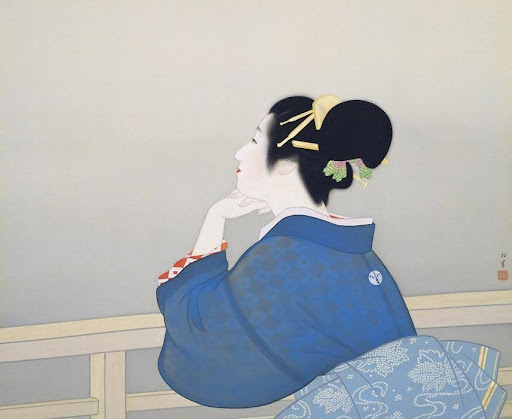17.待月
(Woman Waiting for the Moon to Rise)
清潔で気品ある女性像の集大成

《待月》は、1944年 松園69歳の円熟期に描かれた傑作であり、近代美人画の到達点とも言える作品。若い女性が欄干に頬杖をつき、月の出を待つ姿を描写。月は画面に描かれていないが、空間には淡い光と影が満ちており、観る者の想像力を誘う。女性の髪型は大丸髷(だいまるまげ)、手絡の色や髷の大きさから新妻であることが示唆される。深い青色の紗の着物に「釘抜き繋ぎ」の文様が透けて見える。臙脂と白に染め分けた襦袢が袖口にのぞき、季節は夏。素材や髪の生え際の描写など、細部に至るまで筆致が冴えている。帯には流水に楓の絞り模様、涼やかさと若々しさを演出。画面に描かれていない「月」を待つという構図が、「人生の節目を待つ美しさ」として解釈することもできる。
Woman Waiting for the Moon to Rise (1944)
A culmination of purity and grace in feminine portraiture
Painted in 1944 at the age of 69, Woman Waiting for the Moon to Rise stands as a mature masterpiece and a pinnacle of modern bijin-ga (beautiful woman paintings). A young woman rests her cheek on her hand against a railing, awaiting the moonrise. Though the moon itself is absent from the composition, the space is suffused with soft light and shadow, inviting the viewer’s imagination to complete the scene.
Her hairstyle—a large daimaru-mage—along with the color of her hair ornament, suggests she is a newlywed. She wears a deep blue silk gauze kimono, through which the delicate kuginuki-tsunagi (linked nail-puller) pattern subtly emerges. A crimson and white undergarment peeks from her sleeves, indicating the summer season. Every detail, from the texture of the fabric to the rendering of her hairline, is executed with refined precision.
Her obi features a tie-dyed motif of flowing water and maple leaves, enhancing the sense of coolness and youthful vitality. The composition—centered on the act of waiting for an unseen moon—can also be interpreted as a metaphor for the quiet beauty of anticipating life’s turning points.
お問い合わせ
〒154-0024 東京都世田谷区三軒茶屋1-39-7